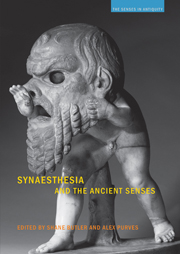Book contents
- Frontmatter
- Contents
- Contributors
- Introduction: synaesthesia and the ancient senses
- 1 Why are there nine Muses?
- 2 Haptic Herodotus
- 3 The understanding ear: synaesthesia, paraesthesia and talking animals
- 4 Aristophanes, Cratinus and the smell of comedy
- 5 “Looking mustard”: Greek popular epistemology and the meaning of δριμύς
- 6 Plato, beauty and “philosophical synaesthesia”
- 7 Manilius' cosmos of the senses
- 8 Reading death and the senses in Lucan and Lucretius
- 9 Colour as synaesthetic experience in antiquity
- 10 Blinded by th light: oratorical clarity and poetic obscurity in Quintilian
- 11 The sense of a poem: Ovids Banquet of Sence (1595)
- 12 Saussure's anaphonie: sounds asunder
- 13 Beyond Narcissus
- Bibliography
- Index
12 - Saussure's anaphonie: sounds asunder
- Frontmatter
- Contents
- Contributors
- Introduction: synaesthesia and the ancient senses
- 1 Why are there nine Muses?
- 2 Haptic Herodotus
- 3 The understanding ear: synaesthesia, paraesthesia and talking animals
- 4 Aristophanes, Cratinus and the smell of comedy
- 5 “Looking mustard”: Greek popular epistemology and the meaning of δριμύς
- 6 Plato, beauty and “philosophical synaesthesia”
- 7 Manilius' cosmos of the senses
- 8 Reading death and the senses in Lucan and Lucretius
- 9 Colour as synaesthetic experience in antiquity
- 10 Blinded by th light: oratorical clarity and poetic obscurity in Quintilian
- 11 The sense of a poem: Ovids Banquet of Sence (1595)
- 12 Saussure's anaphonie: sounds asunder
- 13 Beyond Narcissus
- Bibliography
- Index
Summary
SOUND SOUND
When I was a senior in college, a classmate of mine, fresh from having been awarded a Rhodes Scholarship, stopped by my room one evening to ask for advice on a paper he was writing on Plato. A philosophy major who knew little Greek, he was planning to claim – and over my protestations I believe did in the end claim – that when Socrates said that someone or something was “sound”, he was referring not solely to somatic and mental health but also to music, for (he earnestly explained to me) was it not the case that just as a beautiful piece of music is held together by the soundness of its sounds, so, too, was it with a beautiful person or thing? Putting on my linguistic hat, I explained to him that the Greek adjective ὑγιήϛ “sound, healthy” and noun ὑγίεια “soundness, health”, as well as the derived adjective ὑγιεινόϛ “sound, healthy”, which we have borrowed into English as hygiene, have nothing to do with music, and I remember all too well the time I spent trying to keep him from getting the wrong idea about the phrase ὑγιὲϛ φθέγγεσθαι in the Theaetetus, which the standard Greek lexicon of Liddell, Scott and Jones translates, perhaps unfortunately, as “ring sound and clear”.
- Type
- Chapter
- Information
- Synaesthesia and the Ancient Senses , pp. 167 - 184Publisher: Acumen PublishingPrint publication year: 2013



